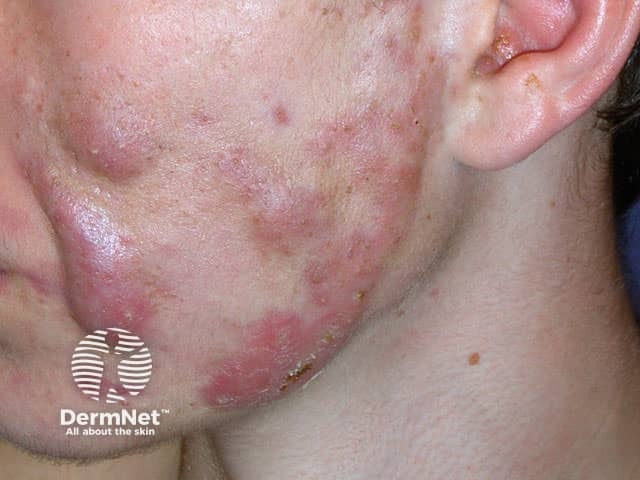Main menu
Common skin conditions

NEWS
Join DermNet PRO
Read more
Quick links
SAPHO syndrome — extra information
SAPHO syndrome
Author: Dr Sarah Hill, Dermatology Registrar, Waikato Hospital, 2006.
What is SAPHO syndrome?
SAPHO syndrome is characterised by any combination of:
- Synovitis (inflammation of the joints)
- Acne (conglobata or fulminans)
- Pustulosis (thick yellow blisters containing pus) often on the palms and soles and similar to palmoplantar pustular psoriasis)
- Hyperostosis (increase in bone substance)
- Osteitis (inflammation of the bones)
The cause is unknown.
Other skin lesions seen in SAPHO syndrome include: hidradenitis suppurativa and dissecting cellulitis of the scalp.
The skin lesions in SAPHO syndrome are characterised on skin biopsy by collections of inflammatory cells, known as neutrophilic pseudoabscesses.
Bony involvement mostly affects the breast bone (sternum), resulting in decreased mobility due to pain, tenderness and swelling. The collar bones (clavicles) are also frequently enlarged on X-ray. Bone biopsy also reveals abscesses, known as sterile osteomyelitis.
SAPHO syndrome is classified along three different spectrums.
- Pustulo-psoriatic hyperostotic spondylarthritis (PPHS)
- Chronic recurrent multifocal osteomyelitis of the adult age (CRMO)
- Imperfect forms of these.
Prevalence of CRMO is estimated at 0.04% whilst the other entities are rarer.
How is the diagnosis made?
SAPHO syndrome is suspected when a patient presents with a pustular skin disease in association with rheumatic pain.
Magnetic resonance imaging (MRI scan) shows inflammation of the bone marrow or joints at characteristic sites such as the collar bone, breast bone, pelvis, heel, and lower jaw.

Acne fulminans
Treatment
SAPHO has no specific drug treatment. It can be a chronic condition but eventually self-heals.
A rheumatologist may manage the joint symptoms, often prescribing nonsteroidal anti-inflammatory drugs or sulfonamides such as sulfasalazine.
A dermatologist may use vitamin A derivatives (oral retinoids) to treat the acne (isotretinoin) and the palmoplantar pustulosis (acitretin).
Other drugs that may be used include:
- Colchicine
- Topical corticosteroids
- Systemic corticosteroids
- Methotrexate
- Calcitonin
- Bisphosphonates
- Infliximab
- Etanercept.
Bibliography
On DermNet
Books about skin diseases
